INSIDE THE BATMAN: Steve Englehart on the Joker’s end, Silver’s big decision — and Rogers and Austin’s “gorgeous f—in’ artwork”…
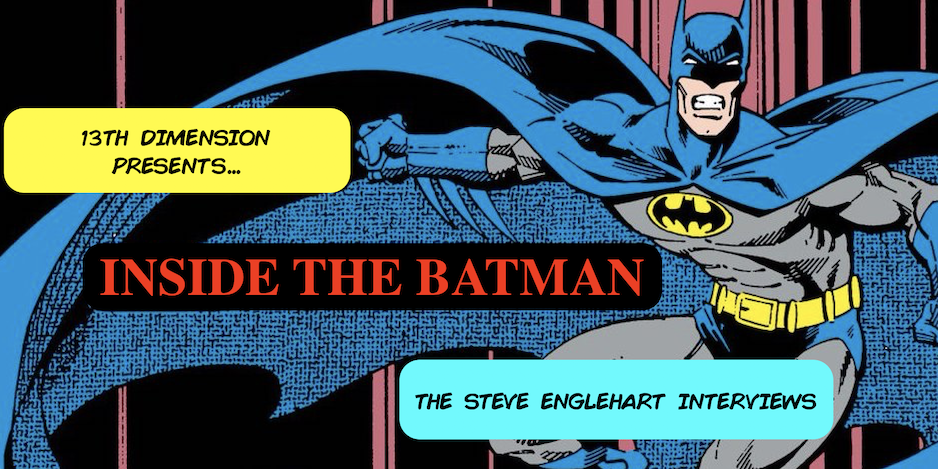
Welcome to INSIDE THE BATMAN: THE STEVE ENGLEHART INTERVIEWS, an issue-by-issue exploration of the greatest Batman story of all time — Steve Englehart and Marshall Rogers’ seminal 1977 Detective Comics run. The complete story has finally been collected for the first time in hardcover — and in the way Englehart envisioned it — in Tales of the Batman: Steve Englehart. With the book newly released, the time is perfect to go back and look at the story from every conceivable angle. Each weekend this summer, we’re diving into a single chapter of the 8-issue saga, with full commentary by Englehart himself — the most complete analysis of the landmark storyline ever published. For the INDEX of individual entries, click here.

So far, we’ve covered how Steve Englehart landed the gig, what he set out to accomplish, what his overarching thoughts are on Batman and the Joker, the Darknight Detective’s sex life, the change in art teams from Walt Simonson and Al Milgrom to Marshall Rogers and Terry Austin and how he structured the story. (Click here.) We’ve also explored the story’s first six issues — Detective Comics #469 (click here), Detective #470 (click here), Detective #471 (click here) and Detective Comics #472 (click here), Detective Comics #473 (click here), and Detective Comics #474 (click here), and Detective Comics #475 (click here), which gave us Silver St. Cloud, Rupert Thorne, Dr. Phosphorus, the return of Hugo Strange after nearly 40 years, the Penguin, the reclamation of Deadshot — and the return of the Joker.
Finally, we’re at the story’s conclusion. Silver and Rupert are miles from Gotham after a chance hitchiking encounter and things don’t go well. After they split, Thorne meets his fate at the hands of Strange’s ghost and Silver returns to Gotham — just in time to see the man she loves in pitched battle with the most dangerous maniac in the city, if not the world…
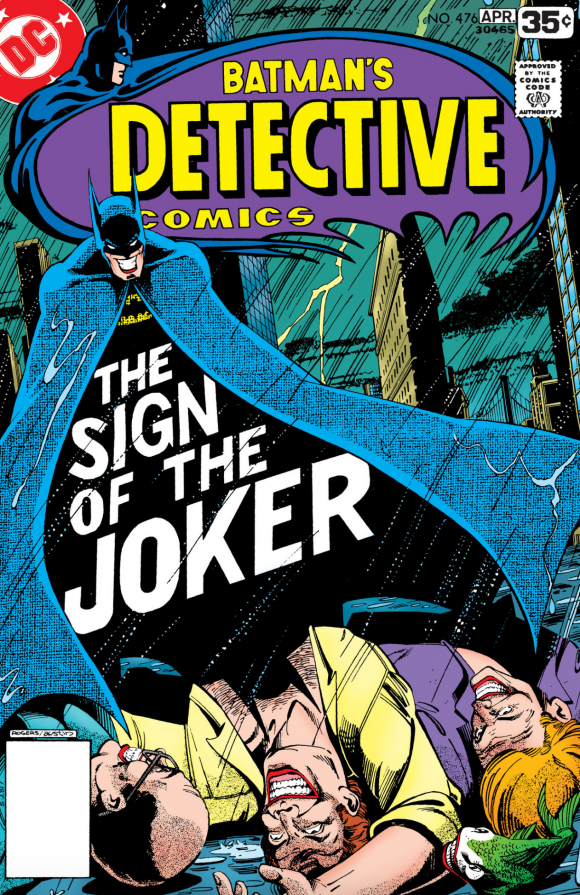
Dan Greenfield: Things really come full circle for both Silver and Rupert Thorne in very different ways here. What jumps out at me particularly is that you have really four pages almost, three pages but then a fourth because of the way it ends, but it’s mostly conversation between two people who are not Batman, not the Joker, not the Penguin, not Robin — it’s these two civilian characters who you have introduced, who come from very divergent viewpoints as far as where the Batman goes, and yet it’s riveting storytelling.
Like you were saying about Detective #474 when they were at the restaurant, here it’s two people in a car and it’s all about the lighting, the angles, the pacing. Talk to me about the craft of putting a scene like that together.
Steve Englehart: Well it’s craft. The lighting is obviously the art, right? I’m sure I said that they’re uplit by the light from the dashboard, that’s my artistic thing, visualizing how this thing could go, but the execution of it is Marshall.
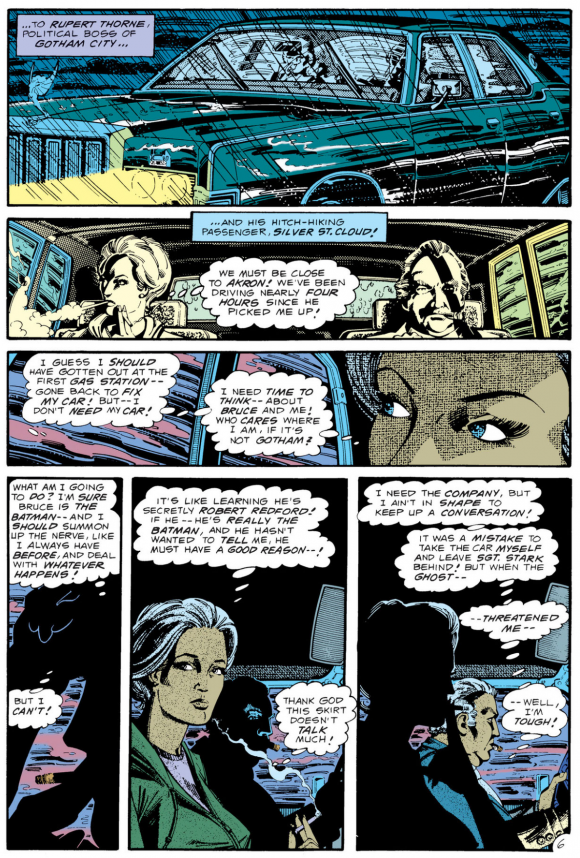
There’s the scene right at the beginning, where in one panel we see Silver and Thorne is in shadow, and in the next panel she’s in shadow. It’s just like, that’s Marshall’s craft, of how to make this look cool visually. I had two fully rounded characters by this time, so put them together.
That’s why I write; it’s to get inside people’s heads and then they have to react to other people whose heads I am also inside. Things had to be said, they had to be said in a dramatic and effective manner.
I love this, I’ve held on to this for years and years and years, but the girlfriend of an artist, I don’t remember who he was and I don’t remember her name, but when I was very, very new at this, she said one day, “Writing comics is like doing newspaper headlines in poetry.” Yes! That’s exactly right. You’re always writing for space, if you extend this you’ve got to take away from someplace else, so you’re always writing as succinctly as possible, but you’re doing characterization, and you’re doing storytelling, and you’re doing atmosphere, and you’re doing all this stuff — but succinctly.
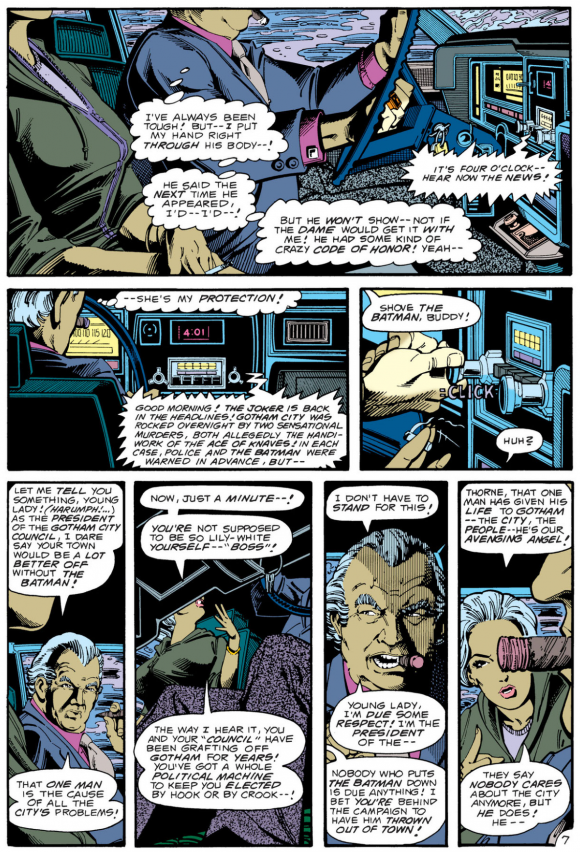
That’s why I love comics. I did write novels, and novels were fun in and of themselves, but I really liked the rhythms of comics, the punchiness that’s necessary for this. This scene with them in the car, you care about it. By this time, hopefully, you care about these people who are not any of the big guns. But the confrontation between Silver, who I hope we like, and Boss Thorne who we think is an asshole but is powerful, there’s that and then we get immediately to the ghost, which is just, you know, the ghost is dead and they’re hitchhiking.
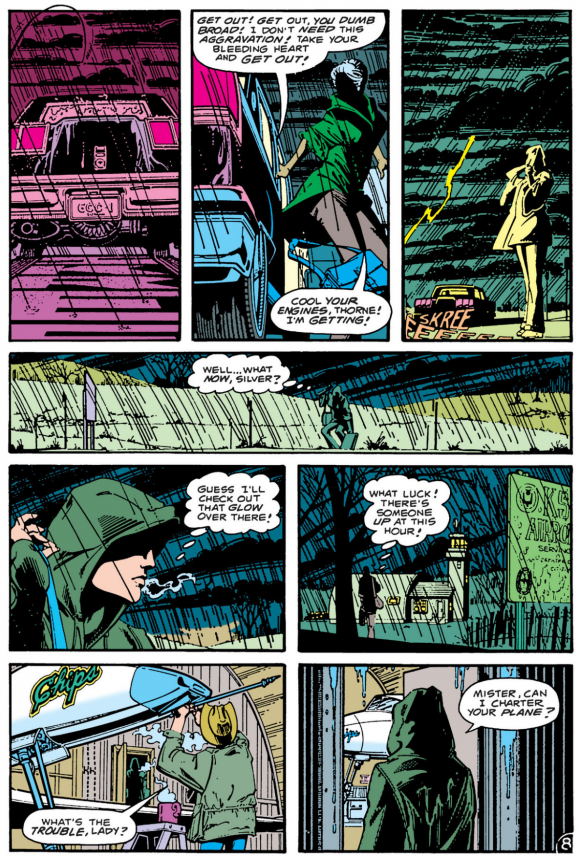
Dan: Those two panels have stayed with me since the first time I read them. Lighting him, lighting her. But it’s not just a conversation there’s a lot of silence. We’re reading a lot of their thoughts, but they’re really sitting quietly for a page or a page and a half before they finally — the radio is what prompts them to converse about Batman. It really is brilliant, and it’s a wonderful part of what makes this particular story so special.
Thorne gets his comeuppance here, of course. We see that something’s happened to him with Strange’s ghost. And she’s decided she’s headed back to Gotham to figure this out once and for all. And of course when she comes back what do we have here but the climactic battle between Batman and the Joker, which is one of the most gorgeously illustrated fight scenes I’ve ever seen in comics.

One thing I particularly appreciate: So often cities are made to look generic, and this to me, particularly growing up in the New York area, is what New York looked like in 1977. That’s what it looked like, that’s what it felt like. Even though it’s Gotham City, it feels like a real place and the battle between the two of them really plays it up with the fire escapes and the different lighting and the different perspectives. Just talk about that, your take on how that all plays out.
Steve: This is the climactic battle that we’d been headed toward. I blithely have said over the last 40 years, with Batman it’s always 3 a.m. under a full moon. And here we are — and a rainstorm too.
I didn’t grow up in New York. I lived in New York for a number of years, not all that many, but I’d come back and visit back in the day. I had a working sense of what New York looked like. Not the way you would, but I knew what New York looked like, Marshall knew what New York looked like.
Marshall had studied architecture and he loved drawing cities, so the realism of the city in the art, that’s Marshall. I’m saying they’re up on a fire escape, they’re up on a girder that’s flapping around, you know, all this kind of stuff. In terms of how it’s laid out, what it looks like, it became much better known. That’s part of the Batman too, Gotham City is part of the Batman.
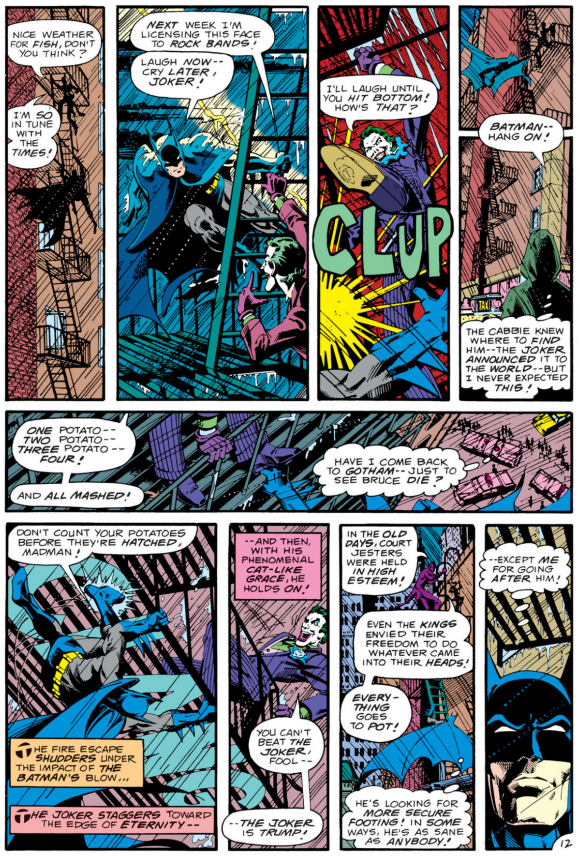
Dan: Ever since the 1989 movie, artists have drawn it like the 1989 movie, even today. They’ve made it distinct and it has its own personality, but to me it makes it more fictional. What I appreciate about this story and really what we saw throughout the Bronze Age is that Gotham City is a stand-in for New York City. In the story, you mention New York as a separate entity, but let’s face it, this is New York. To be able to see that, that kind of realism I think adds so much power to that particular scene because it feels like real life, it doesn’t feel like a fantasy world.
Steve: Yeah. I mean I understood that, and I asked for it. But again, if somebody else had drawn it, it wouldn’t have looked like that. All kudos to Marshall.
Dan: On the final page of the fight, where the Joker gets zapped and he plunges and it’s kind of an unorthodox layout, where the background of the page is basically the complete view and there’s like three insets that show you the sequence of what happens. Did you lay that out in your mind, or did he decide to lay it out the way he did?
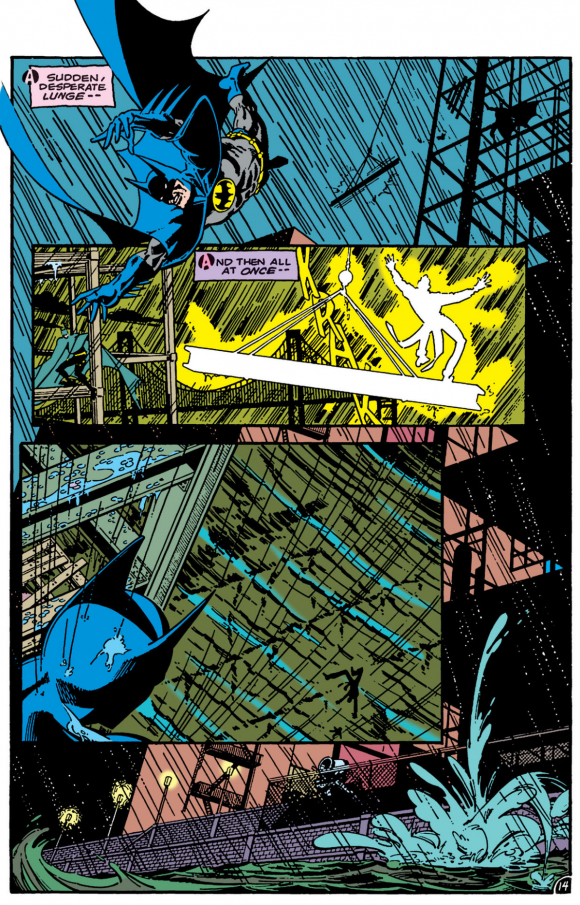
Steve: That’s him. I asked for the particular panels with the particular things happening in it. Marshall by this time, he’d been fully invested from the beginning, but every issue he was getting better control of his craft, the story’s building so he’s able to feed off of that, all that kind of thing.
You get that final page and then you immediately go to Silver St. Cloud. I can tell you, I didn’t have that many panels when I wrote this thing. The dialogue’s all there, but I had it done in fewer panels. That’s Marshall going, I’m gonna make this page look like this. When you have an artist that’s just having that much fun, you’re going to get that stuff.
Dan: You gave the Joker a classic “you don’t see the body” death. Because you can’t kill the Joker. In a way he has to die, but you always have to leave the door open for him.
Steve: Right. Unfortunately if I may say, in later years toward the end of my time at DC, they asked me to do a two-part thing with Aquaman and the Joker, and it’s in the (hardcover) book. There’s a two-part thing which basically starts as the Joker hits the water and then he gets involved with Aquaman. I’m not real thrilled with it.
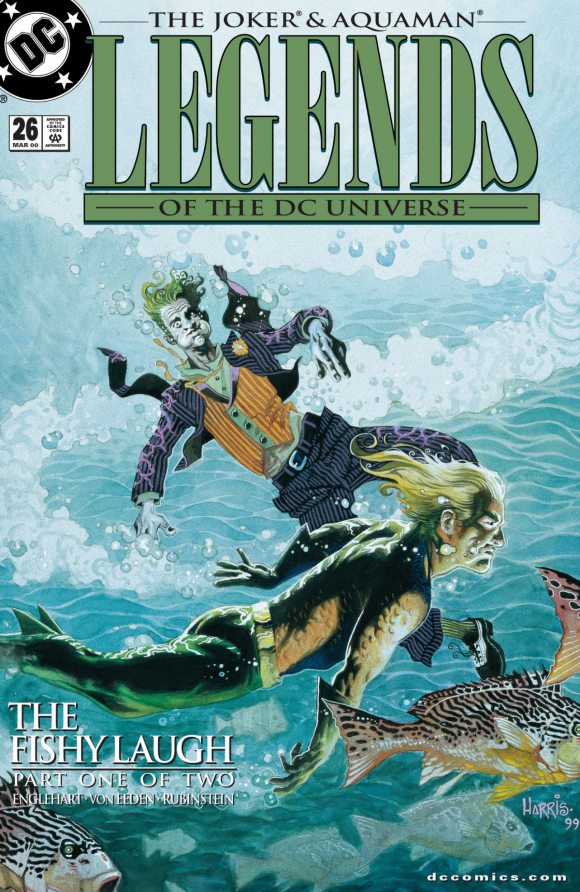
Dan: I’ve written plenty of things that I look back on later where I’m like, “I really wish I hadn’t done that.”
Steve: By the time that came around, I was well down the road of not being happy with DC and they didn’t like me either because I said mean things about them, and so if anybody did come around and ask me to do something it was probably sort of obscure and weird. And so, if people buy this book, they will get the two-parter after this where the Joker goes to Atlantis and stuff. It’s just bullshit! I don’t recommend it at all. But there it is.
There’s another story actually I should just mention one thing about, in this compilation: There’s a one-shot about Bruce Wayne’s first week on the job, when he’s still trying to hold on to a different girlfriend, and the story is basically about telling your girlfriend, well I’ll come by at midnight and then you don’t get there ’til 2 in the morning because you’re the Batman, but then how do you… you know. That was what that story was about, and that one I liked.
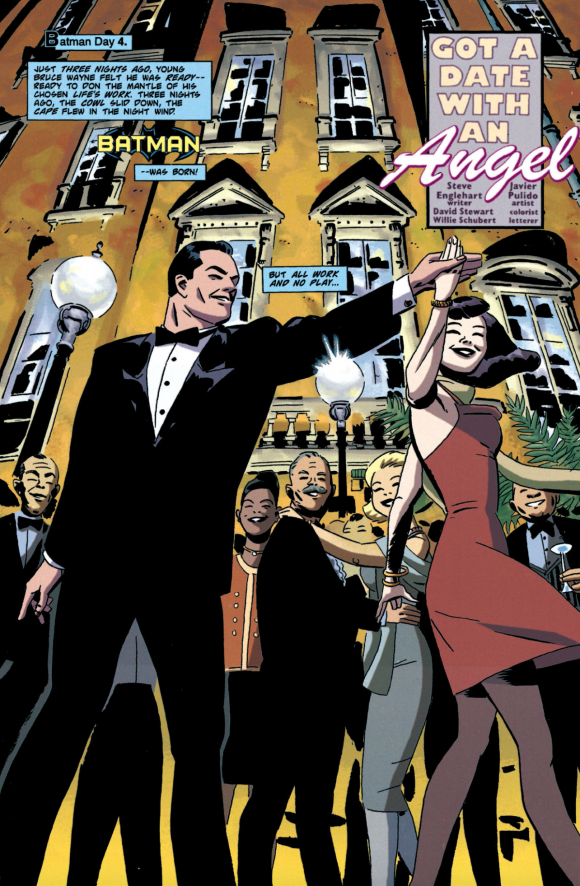
The Batman Chronicles #19 (1999)
Dan: The last thing of course, is the scene between Silver and Batman where she really does the talking. I think it’s notable and noteworthy that typically it would be Batman who would be ending things. You make the point that he’s not the one who breaks it off with her. She’s the one who breaks it off with him.
Steve: Strong woman, right? Strong, stands on her own two feet, she’s got the ability to do that. And he is actually interested in her. I hadn’t written this story about how hard it is to have a girlfriend if you’re Batman. In the follow-up story*, 30 years later, she’s with somebody else, but he’s still — 30 years or 30 days, it’s sort of hard to tell with comics — she’s the one that got away, but she’s with somebody else now. He’s too good a guy to like, mess with her. And then in the unpublished third run, they get back together.
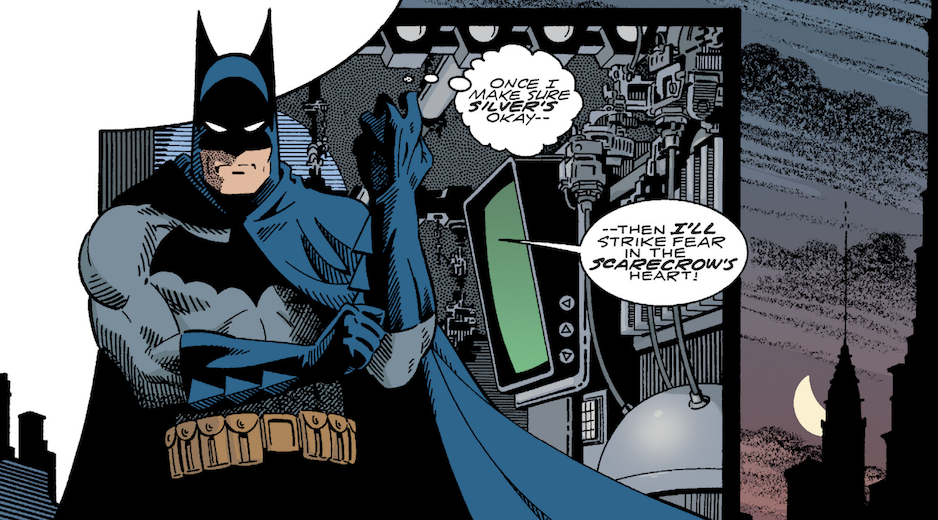
Batman: Dark Detective (2005)
(* Since the full, original arc has no official name that has stuck, Englehart refers to it as Dark Detective. Meanwhile, his 2005 miniseries sequel was officially called Dark Detective, so Englehart considers it to be Dark Detective II. Click here for much more.)
The whole third one — this isn’t in the book so people will have to download it, but after the second one, Evan Gregory, her boyfriend at the time, has had his left arm and his left leg cut off. So he needs her. She doesn’t want to be with Evan Gregory, but he needs her so she’s doing that. Meanwhile Batman is saying “I can’t do this, it’s too weird.” So he goes to London. He gets out of Gotham City. Because there’re billboards — Evan Gregory’s still running for governor, right, so there’re billboards with Evan Gregory’s face on it. The campaign slogan is he fought the Joker, he’ll fight for you.
All these characters, I’m just working them forward, but the third one ends with them getting back together. If I were writing the Batman on a continuing basis, she would be his girlfriend. Not just eye candy, she would be part and parcel of the thing. She would be part of the ongoing story, and it would be how does he make this work or is it impossible? If I were to keep writing it, it’s quite possible that it really would be impossible. If that makes any sense. For him to actually have a girlfriend.
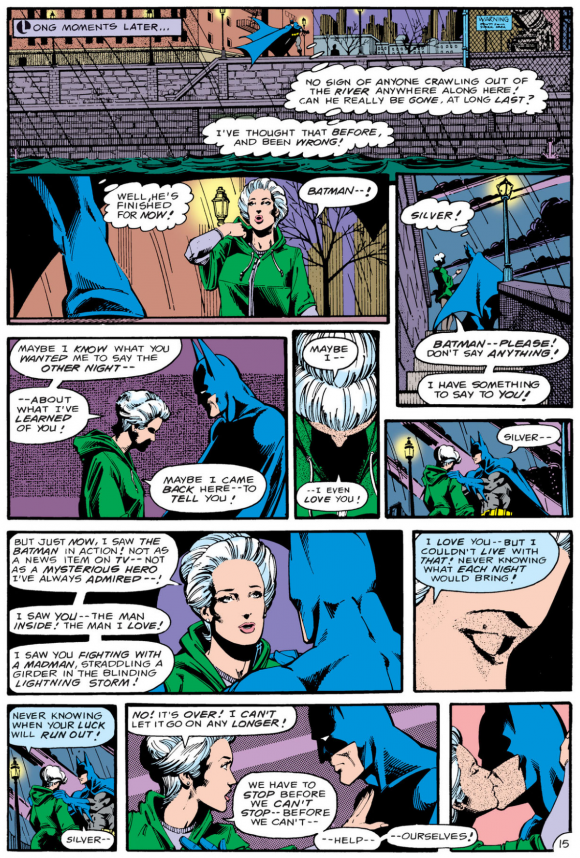
But she’s somebody I can see rolling with this. She’s somebody who isn’t going to sit around going, “Why didn’t you come home at midnight when you said you were coming home!” She’d be behind him. But there is no Dark Detective IV. In the download stuff I have the plot, a one-page synopsis of the plot of what the fourth one is, which is where he and she have to fight their way across Gotham City, between midnight and 6 AM. I got plenty to do with Silver St. Cloud, but I left. DC wrote me out of the picture.
Now she’s sort of out there somewhere and it’s all Catwoman or whatever it is now. If this had been my regular assignment, we would have gone forward with this. We come back to what I said about organic stories — I honestly don’t know where that would go. It would be fun for me to take it, to move it along. In the second one, their relationship as they kind of get back together and all that, we follow them through that.
At the time (1977), this was my entire Batman run. This was all I was going to do. I couldn’t leave her as his girlfriend for Len Wein or whoever was going to come along next, because that would have changed everything and I would have left and then other people would have had to mess with it. So the idea that she’s strong enough to go, “I love you, but I can’t do this. I know myself, I can’t do this.” And he, throughout this book, he doesn’t talk much. Batman is a silent sort of figure. He’s larger than life. He plays at being larger than life. I mean the Joker is larger than life. Batman becomes the thing that will scare criminals, but that’s not Bruce Wayne. I mean it is Bruce Wayne, but Bruce Wayne has got other things going on.
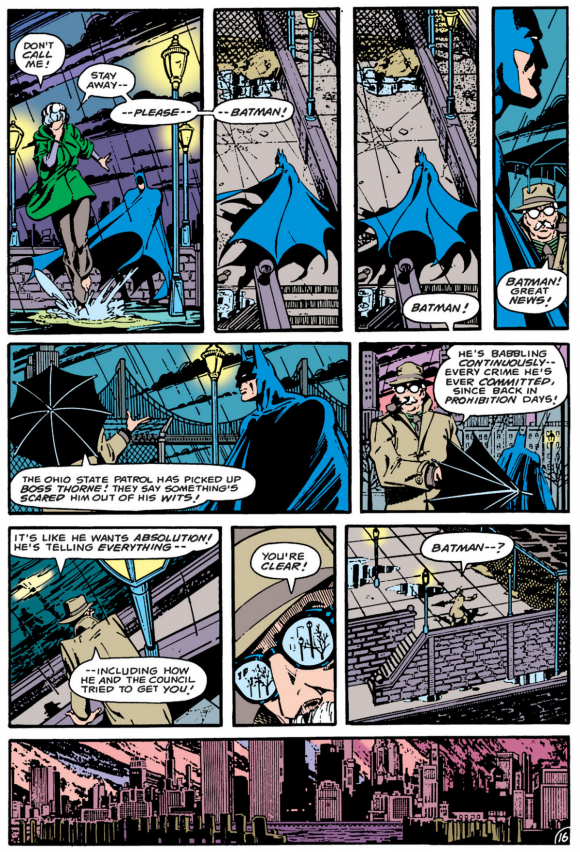
Dan: It’s calculated.
Steve: Yeah, and as Batman he’s not likely to break into long soliloquys or anything. When he’s wearing that costume he’s — that’s what I think really shows up here, that he’s wearing the costume, he is the Batman, he just fought the Joker, he’s definitely the Batman, but you can see that it’s Bruce Wayne too. That it’s a guy there whose girlfriend is breaking up with him. He understands it, he’s a strong character too, but for the purposes of this story they can’t make it work.
If the third run had been published, if there had been a fourth run where I continued to explore this, it’s quite possible that we would come to a thing where they go, “We really can’t make this work. This is really not going to happen.” But, I hadn’t gotten there yet, as I went forward. At this point in time, this was the end.
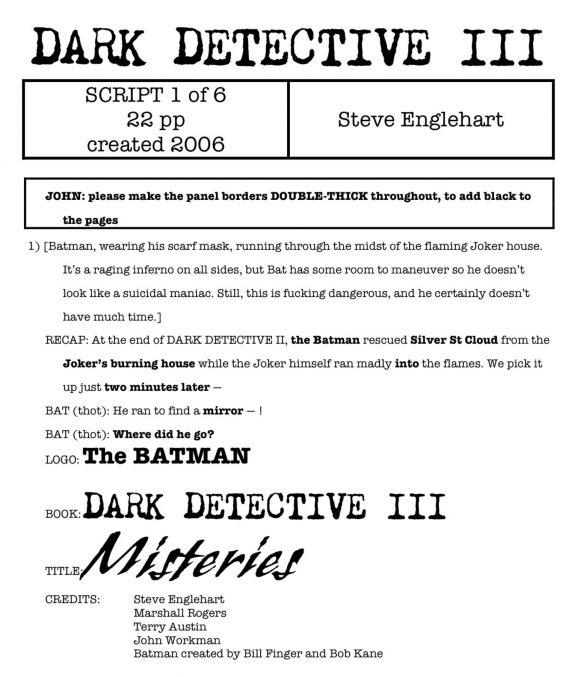
From Englehart’s unpublished Dark Detective III (2006)
So she breaks up with him, and again, gorgeous fuckin’ artwork. The page where they talk, Marshall broke up all those little panels and took some of my panels and broke it into two or three pieces and stuck them all together, and then the next page where you watch his cape just kind of like, settle. It just like – mrghrgnhuhh, deflated. And he hasn’t moved! He hasn’t spoken. And he doesn’t move or speak until all of a sudden he’s just gone. That’s all precisely what I wanted. Expertly rendered by Marshall. And Terry!
I mean Marshall’s the penciler, but Marshall’s pencils are very gray (or were). Marshall didn’t spot a lot of blacks, he didn’t do that, he left it for the inker. And so a lot of the blacks in here – which is important as hell — is Terry Austin too. I keep saying Marshall did this and Marshall did that, in terms of layout and all of that, yeah. But the overall look of it, a lot of that is Terry Austin too.
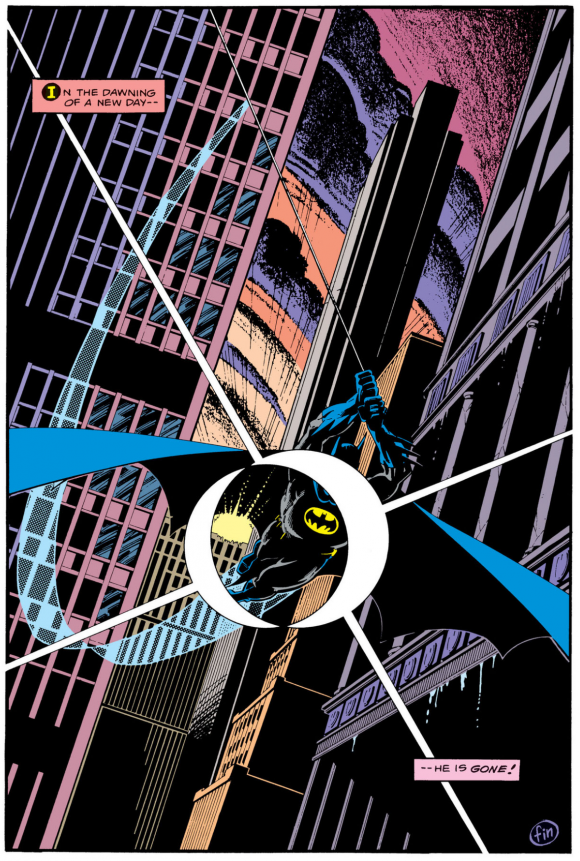
Dan: The final page – I always took that to be sort of like, lens flare. You’re sort of on the ground looking, the sun’s rising in the background, so you don’t get quite as good a look at Batman as you might. Was that effect — I don’t know if it was your choice or his choice…
Steve: His choice. The dialogue is right there: “The dawning of a new day, he’s gone,” and that was actually also referring to me, because now I’m going to Europe, you know? That’s the end of my Batman. So I was referencing myself there as well, but the way Marshall laid it out with the lens flare, that’s him. Works great. But you wouldn’t ordinarily think… nobody puts a lens flare in a comic, right? But that’s him doing the stuff that he did. So we were a good team.
—
NEXT: Lightning Round!
—
MORE
— INSIDE THE BATMAN: THE STEVE ENGLEHART INTERVIEWS Complete INDEX. Click here.
— PART 7: DETECTIVE COMICS #475 — THE LAUGHING FISH — and How to Make THE JOKER Truly Insane. Click here.

August 16, 2020
I love me a great Adams cover or interior art. But, this run was the whole package. It’s my version of BATMAN for the Bronze Age. Just as Adam West is my visual live version. How great would it have been had it been a much longer run. Classic. Timeless. You want to thank the creators. They gave life to your heroes. Thank you, Steve, Marshall and Terry!
August 16, 2020
Fascinating stuff, thanks to you and Steve. That last page, though, I never liked the lens flare, I got it, but it was unmotivated, and too precise. None of which stops this being a classic image!
August 16, 2020
This interview is in and of itself a masterpiece.
August 17, 2020
Mr. Englehart,
If you happen to stop by, first, thank you for writing these wonderful issues of Detective. They are among my favorites in Batman history. Also, thank you for consenting to do these in depth interviews. Seeing how you developed the stories was a fascinating read.
Mr. Greenfield,
Thank you for sharing this on your site and for you insightful questions.
As for the late Marshall Rogers, I was only five or six when I got Detective 471, and, even at that age, I realized this art was something special. I think spring 1976, when I began collecting was a good time to come in. Englehart/Rogers/Austin on Detective, Aparo on Brave & the Bold and Neal Adams in the Batman book & record sets and reprints in the treasury editions.
January 22, 2021
I didn’t read these Englehart interviews when they were first published. But today, January 22nd, 2021, is Marshall Rogers’ birthday, and I have always considered his work with Englehart and Austin on Detective to be among the finest comics ever produced, so I decided to take the time to finally read them now. To be sure, I appreciated the insights Mr. Englehart provided, but… this final installment…. Dammit it, Steve — you made me cry! Thank you. Thank you for your remembrances. Thank you, Mr. Greenfield for conducting and compiling these interviews. Thank you, Mr. Austin, for all the brilliant work you’ve done in the field. And… thank you, Marshall, for showing everyone how to do The Batman properly! (Damn, I’m crying again.)
January 22, 2021
Thank you, Jim! This interview series is one of the things I’m most proud of at 13th Dimension. It was incredible to do and an incredible honor to publish.
November 25, 2021
That was a lens flare?! I always thought it was a target! You know, symbolizing the reason Silver couldn’t stay with him?
I wonder how many others got that impression. I can see the lens flare now that it’s pointed out, but it really doesn’t look much like one.